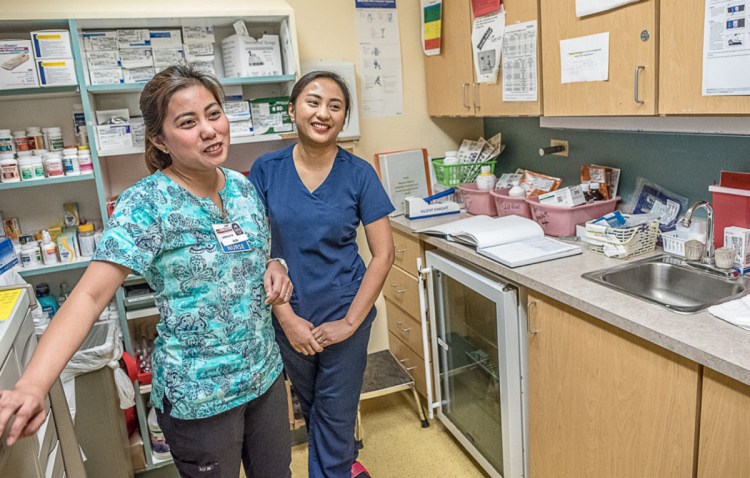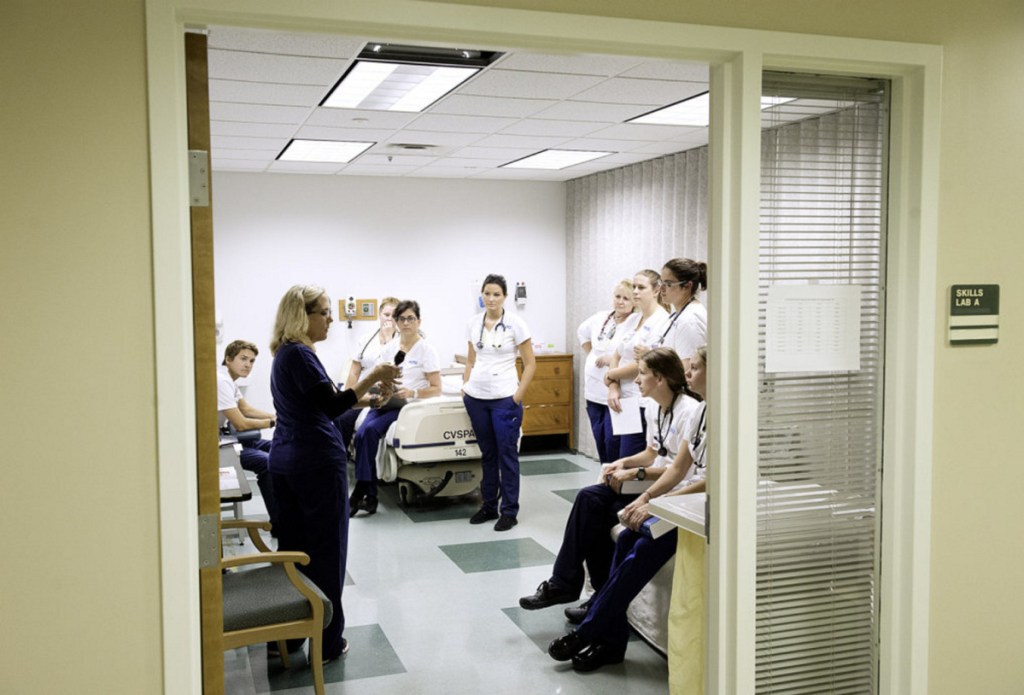LEWISTON — For a while, they tried bringing nursing students pizza.
It was a way for the St. Mary’s Health System’s talent acquisition team in Lewiston to connect, to introduce themselves, to say, hey, St. Mary’s has some job openings for you, future nurses. A lot of openings.
They attended local college coffee-and-doughnut hours, too. And blanketed job fairs. They offered to help pay for school for current employees interested in getting into nursing and for nursing students who would agree to work at St. Mary’s for a while after graduation.
They offered signing bonuses of up to $10,000.
“We exhausted every recruitment strategy we could think of,” said Lisa Cramm, system manager of talent acquisition for Covenant Health, which owns St. Mary’s.
So with 70 to 75 openings – 20 at its nursing home alone – St. Mary’s decided to try something bolder.
It went to the Philippines.
In August and September, 13 experienced Filipino nurses joined the staff at d’Youville Pavilion, filling more than half of its 20 openings. It’s the closest the nursing home has been in a year to a full staff of permanent nurses.
Nursing director Marissa Varney called it “a blessing.”
“It will be good for our patients, first and foremost,” she said. “We’ve used travelers (short-term contract nurses who travel from place to place), but they’re only here for 13 weeks. Sometimes they extend it for another 13 weeks, but it’s not the same. Having the continuity with staff, having the patient know who’s taking care of them, it’s big. It’s huge.”
GAPING SHORTAGE
It’s no secret that Maine has a nursing shortage and a crisis looming not too far off. Maine needs hundreds of registered nurses now. It’s predicted the state will be short 3,200 by 2025.
That’s gotten some organizations worried. If pizza parties and signing bonuses aren’t helping, what will?
For St. Mary’s, it meant looking outside the country.
Because they have their choice of jobs, nurses in Maine are generally more interested in working in a hospital, where they can focus on emergency medicine, labor and delivery or any number of other specialties. By comparison, long-term care has the reputation for being somewhat dull.
Nurses in the Philippines, it turns out, were OK with that.
‘WE NEED YOU’
While St. Mary’s couldn’t find nurses, nurses 8,000 miles away couldn’t find jobs.
The Philippines had more nurses than work available. And the jobs they could find weren’t great, particularly at government hospitals, where nurses might earn $200 to $600 a month and have to wash and re-use gloves and gauze.
Some figured their best option lay in another country.
D’Youville happened to have a couple of longtime staff members who were originally from the Philippines, including Varney, the nursing director. When it became clear St. Mary’s couldn’t find nurses close to home, they suggested searching overseas.
“They just kind of tossed it out there,” Cramm said. “We started researching.”
This spring, the hospital system signed with PassportUSA, an international health-care staffing agency. The agency presented a pool of 30 candidates. Relying on resumes and phone interviews, St. Mary’s initially offered jobs to 14.
The nurses didn’t have to take the job. Some had worked in other countries, such as the United Arab Emirates, and they could have continued that work. Some had multiple interviews in United States and could have chosen to work somewhere other than St. Mary’s.
But while they could have said no to the job offers, for some it was the realization of a dream. They’d wanted to live and work in the United States for years.
“Even when I was a child, I already dreamed of coming here,” said Millicent Moreno, 30.
One of the 14 dropped out for personal reasons. The other 13 said yes to St. Mary’s.
The agency handled their work visas and dealt with the logistics of getting them to Lewiston, including finding them apartments, getting them cellphones and making sure they were comfortable driving in America. The nurses began arriving last month, some with spouses and children in tow.
They come with the same kind of training and required licenses as American nurses. They speak English. They’re from a country whose population is largely Catholic, so they’re familiar with the essence of St. Mary’s, a Catholic hospital system.
There has been some adjustment. Many of the Filipino nurses had experience with hospitals, where one nurse might be responsible for five patients. At d’Youville, which provides long-term rather than acute care, two nurses might have 40 patients between them.
“For me, I was shocked,” said Janelle Bacani, 30.
St. Mary’s may soon get more than those 13. Some of the nurses’ spouses are trained medical professionals, and plan to join St. Mary’s on their own – possibly as nurses.
“Soon, all of our husbands will start working here,” Moreno said.
The nurses will stay at St. Mary’s for three years under contract. After that, they can go somewhere else through the international staffing agency, or they can stay on at St. Mary’s. Just a month in, some are already talking about staying, raising their children in Lewiston, bringing family to Maine.
This is a kind of pilot program for the hospital system, but Cramm can already see more international hiring in St. Mary’s future – and maybe not just for its nursing home.
“Because it’s worked out remarkably well at this point,” she said. “Obviously we’re still in the early stages, but if it continues to be so positive the way it has been, I am confident this will be a strategy we’ll use again.”
Lindsay Tice can be contacted at:
ltice@sunjournal.com
Send questions/comments to the editors.



